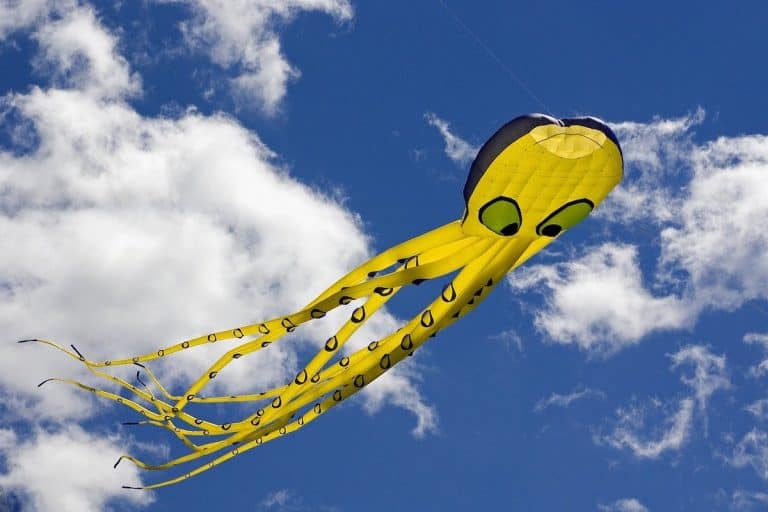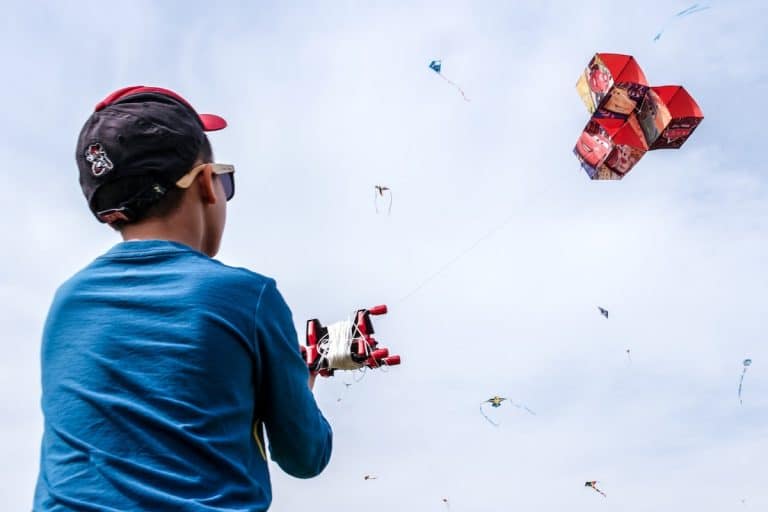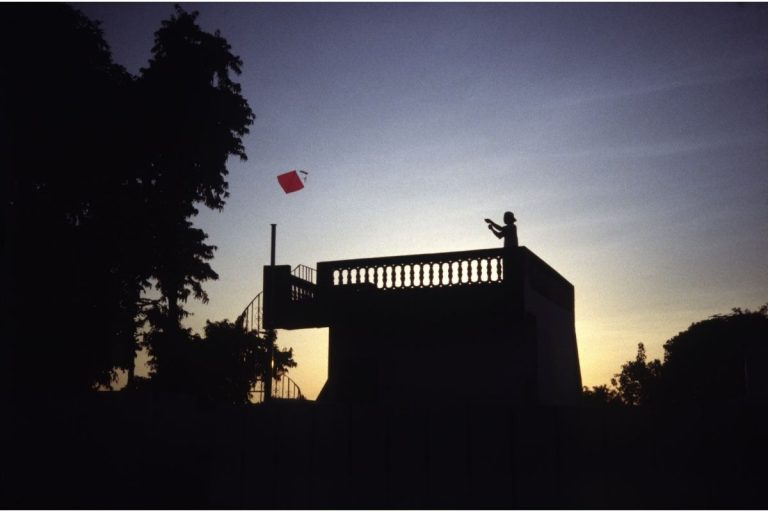The Dos And Don’ts Of Kite Flying
As with every sport, rules are prevalent for success in kite flying. This article covers the dos and don’ts in kite flying that every operator should know.
Kite operators should fly in wide-open spaces free of obstacles and check wind speeds before taking the kite out. Kite flyers should keep a distance from spectators, avoid flying kites in the rain, and stay clear of power lines and highways.
The Dos And Don’ts Of Flying Kites
NASA is one of the international bodies that deal with flying experimental air crafts, space shuttles, and kites. The organization takes safety seriously in all of its undertakings. It encourages awareness of both things and people around one’s surroundings that can cause harm to the aircraft or that are at risk from flying objects (Source).
The first thing one must do when getting into this sport is the purchase or pick a kite. There are a variety of kites in the market, each suitable for particular winds. Diamonds and deltas can be flown in light and medium winds, while stronger winds suit the parafoil kites. Proper assembly of kites is also necessary, and without it, kites may not launch.
Kite flying is an activity that is enjoyed by many. Kite fliers should slow down and enjoy themselves. All this while practicing safety and not being a danger to themselves or others. When operators disregard mindfulness and safety practices while flying, accidents may occur.
One freak accident occurred when a man was left hanging by a thread when kite flying in Sri Lanka. Nadarasa Manoharan was swept off his feet and into the air after the gusty wind got hold of his kite. The kite carried him 30-40 feet. He crashed to the ground and sustained minor injuries (Source).
While talking to Newswire, the gentleman mentioned that those behind him had let go of the kite, but he hadn’t realized it. The kite began to rise and pulled him with it.
A child flew into the air after being caught in a kite in a separate incident in Taiwan. A 3-year-old child entangles on the tail of a giant kite during an international kite festival. Several individuals prepared the kite’s tail while spectators saw the kite billowing (Source).
The event organizers let go of the kite, and it was at this point that they saw the toddler dangling from the tail. The child was in the air for around 30 seconds before the audience could save her. The mayor apologized, and the event was cut short. The winds that afternoon were powerful and unsuitable for kite flying (32-38mph).
Therefore, kite flyers need to take safety seriously. A loosely winded kite or a crashing kite can hurt someone when pulled across a field. Other than caution, courtesy is also necessary. Kite operators should be polite, and non-kite operators do the same by considering their peace and sharing the sky.
Other safety issues may occur when kite flying. For example, kites stuck on power lines can result in blackouts or electrocution of the kite operator. Wet kite strings or wire lines are also conductors of lightning and electricity during stormy weather.
As seen above, kites with powerful lifts or large surface areas can lift people off the ground. There is also a limit to how high kites can fly in various urban areas. It is often the case in regions around airspaces.
Kite flyers should do three main things to succeed in their kite-flying session. These include picking the right conditions, finding the suitable space, and using the proper technique.
Finding the right space
Kites appreciate a lot of room. Bigger flying spaces result in happier kites. They become bumpy when winds go around hills, buildings, and trees. It is also known as turbulence. Obstacles at the back of kites also cause them to crash. It is because turbulent wind draws kites in (Source).
The areas should be open and have steady winds. Wind flows in varying directions and speeds. Smooth wind prevails in flat areas that are free of obstructions. Flying in the turbulent wind is possible but difficult. If one manages to launch a kite in the rough wind, one should fly it high to avoid the bumpiness (Source).
However, areas free of turbulence allow for a smoother flight. Therefore, the best kite flying spaces include beaches, open fields, and parks. When flying kites with dual lines, one must create distance between operators and other people in the flying areas. Also, more space allows for letting out more lines (Source).
Find The Right Conditions
The wind is an essential part of kite flying. Without it, flying kites would be impossible. The type of kite one has determined the amount of current required to lift a kite. Kites that are heavier require more wind. However, some structures rely on little wind for them to fly.
Most kites opt to fly in average winds. There is a high chance one can fly a kite if the wind blows on one’s face. Waving flags and rustling leaves is another great way to measure the amount of current. In such scenarios, kites can fly (Source).
However, if flags are flapping or trees themselves are swaying, it is more likely that the wind is strong. While the wind is invisible, experienced kite operators learn how to predict wind speeds by observing how things around are affected by it.
Wind
Extremely light or strong winds make it difficult to fly kites. Speeds of 5-25mph are ideal for most kite operators and their kites. Merely holding the kite up can get boring. Fortunately, with medium winds, one can pull and let out more lines and dance the kite across the sky (Source).
Autumn temperatures are great for playing in the outdoors before the winter cold arrives. The breeze allows kite flyers to take out their kites. Aerodynamic kites require minimal wind for flying. It means that kite shape plays a prominent role in kite flying (Source).
Light kites require minimal wind even if they have large surface areas. Heavier kites need more lift to get them airborne, which means strong winds are not advisable. They can lift kite operators or crash the kites, mainly if the wind is unsteady.
Winds can be unpredictable, and this is likely due to gradient wind. Gradient wind means that winds that are further from the ground are stronger. In 1805 Francis Beaufort designed the Beaufort scale. This system opts to estimate winds in the absence of instruments. The scale is handy outdoors when specialized equipment is unavailable (Source).
This scale interprets the effects of the wind on the physical environment. Through this scale, making an educated guess about whether to fly a kite or not is easy and possible. When at sea, the scale is also helpful.
Instead of making guesses, kite operators can use weather apps to determine wind speeds. It can avoid inconveniences if the kite-flying location is far away (Source).
Use The Correct Technique
Before flying a kite, operators should inspect the kite. Different kites perform differently in the sky: power kites, stunt kites, single-line kites, and dual-line kites. Operators should consider how the attachment of the kite is, if it requires a tail, or if the line is secure (Source).
Some supplies may be helpful during the flying sessions. So they must be carried along. They include sunscreen, a hat, a first aid kit, sunglasses, a sun umbrella, and gloves.
When flying single-line kites, various essential procedures are necessary. Operators should stand with their back to the wind. Flying should start by holding the kite at the harness and letting the line out. In light winds, operators should ask friends to help them launch the kite. They should hold the kite downwind (50 feet away) and hold it up (Source).
When a helper is unavailable, operators can prop the kite. It can be against a bush, wall, or post. There should be enough line, and the kite must experience a pull. Operators should lay out the lines for sports kites that require multiple lines before launching. Players should then attach the connectors and straighten the lines.
Another important factor to consider is line length. Enough lines around 60′-100′ allow for reaction time. The lines should also have similar measurements because uneven strings can cause the kite to spin.
What Are The Rules Of Kite Flying?
One of the essential rules of kite flying is to stay far from passers-by and spectators. Sport kite flyers are entirely responsible for the behavior of their kites. Hence, avoid crowded areas.
Mindfulness is required when flying kites. The excitement of kite flying can cause one to be oblivious of what is in their surroundings. One should be aware of what is behind them, such as bags, holes, children, cliffs, and fences.
Kite operators should understand that all people have the right to enjoy fun and public areas such as parks. They should, therefore, be considerate of this. Ways they can do this are by not being rude and disturbing others by flying noisy kites. Patiently observe children and other spectators as they are curious and may be unaware of the dangers associated with the sport.
Animals shouldn’t be disturbed or scared. It mainly applies to horses that have riders with them. The scare could quickly become fatal.
Kite Safety 101
Flying kites over or near people is also unacceptable. A momentary loss of control over the kite can be detrimental. Some kites move very fast, reaching speeds of up to 80mph. Being hit by kites moving at such speeds can send spectators or those minding their business to the hospital. The same goes with power kites moving at slow speeds.
Great tension is also placed on kite strings by kites. When this happens, kite lines become razor-sharp. It can result in cuts and bruises for those the kite comes across. This sharpness can also harm the hands of kite operators. That is why it is necessary to wear gloves.
Kite operators should also focus on their moving kites. If anything goes wrong, there can be a quick correction. Letting a large amount of line should also be avoided. When kites get very high up, it becomes difficult to see them and also hard to enjoy the sport.
The chances of accidents happening at high altitudes are very high. It will also be tedious to wind in the kite line. Operators should ensure that they fly a kite instead of letting it fly itself. It is through maintaining control when the kite pulls hard (by letting outline). And bringing in the line when it becomes slack.
When Should You Not Fly A Kite?
It would be best if you did not fly kites when the areas available aren’t spacious. The ideal locations for kite flying include near shores and open fields. Disregard kites that get stuck on trees. Flying near highways should be avoided. One can get hit by a car while chasing after kites, or the kites can be at risk.
Kites can also easily distract motorists. It may cause them to lose control of cars and can cause accidents.
Flying near houses can also cause damage to windows and roofs. When kite flying, avoid flying close to high-tension wires. Operators may experience electrocution if their kite strings touch such lines.
When it comes to electric lines, there are several factors that kite flyers should keep in mind. Kite flyers should operate kites in dry weather, and they should be away from cell phone towers and radios. Construction materials used when making kites should include paper, plastic, and wood. Avoid metallic items because of their ability to conduct electricity.
Please do not underestimate the wind current because it can cause injuries. If using hard-pulling kites, use gloves when flying. While it’s uncommon for dogs to pull kites in the air, landing a kite near dogs may cause an attack.
Why Should You Not Fly Kites?
It would be best if you did not fly kites when appropriate flying materials are unavailable. Kite flyers lacking the necessary skills for stunt and sport kites should first gain the required technique before operating such kites.
Kite operators are responsible for damages caused by their kite systems. Therefore, operators should draft pre-flight plans to avoid accidents and hazards. Proper wires are imperative, which means you should avoid piano wires, fishing lines, and steel wires. These lines tend to stretch and break. They are only best for specialized applications (Source).
When lines move fast, they can act as razor blades and easily cut through flesh. Various fatalities have occurred due to the abuse of kite lines. They should therefore be used far from people and maintained regularly. They wear with time and weaken when knots form on them. Replace them when needed.
Kite fighting is a sport common in India, Indonesia, Nepal, and Bangladesh. However, it has also been the most significant cause of accidents. It is because kite fighting utilizes specialized lines known as Manja lines. These lines have a sharp glass covering (Source).
The severity of the accidents ranges from cuts on fingers to death. Over the years, more abrasive compounds have proved helpful on the lines. It has led to several bans, mainly because kite fighting occurs during festivals, exposing a crowd of people (Source).
Besides being harmful to human beings, kite fighting has also been detrimental to animals. Kites that have been cut down and abandoned have gotten stuck on trees and caused harm to birds. Many of the birds take several weeks to recover.
How Can We Enjoy Kite Flying Safely?
Kite operators should be well aware of their limitations and avoid flying kites that are too large or complicated. Different kites also fly well in particular wind conditions. Light kites, for example, should not fly in gusty winds (Source).
Summary
Kite operators should abandon kites stuck on power lines and trees as they are better off purchasing new kites. Also, corrections must occur upon determining a problem. Add tails as it ensures the kite’s stability. Also, checking wind speeds before going outside can go a long way in ensuring safety and satisfaction.




